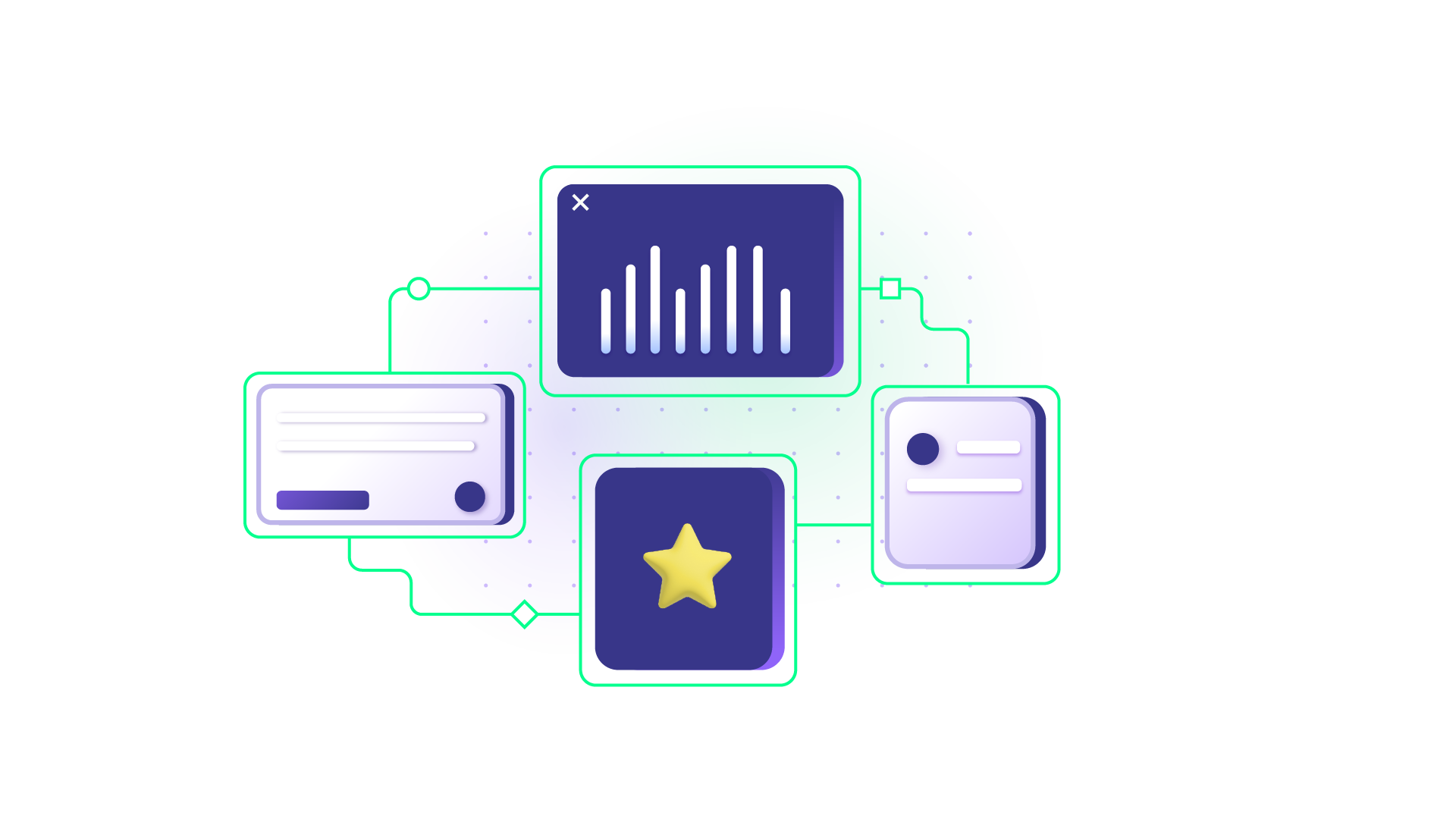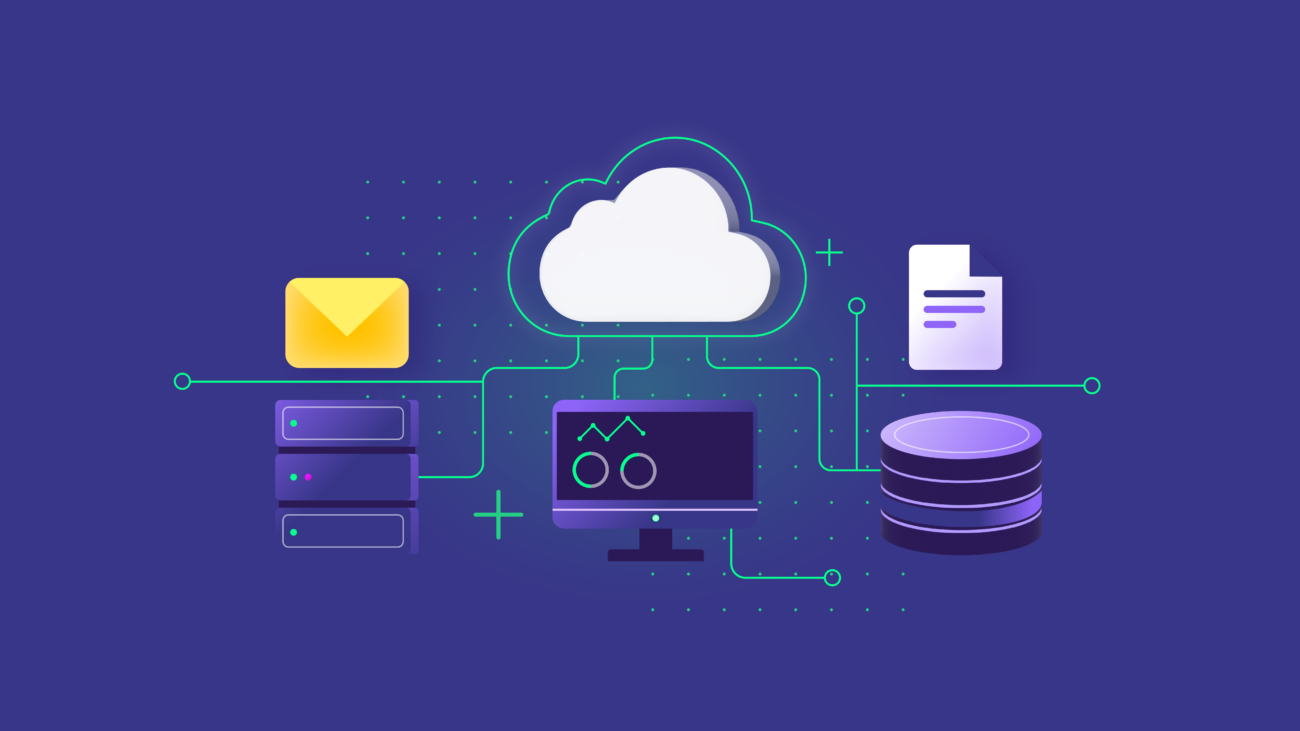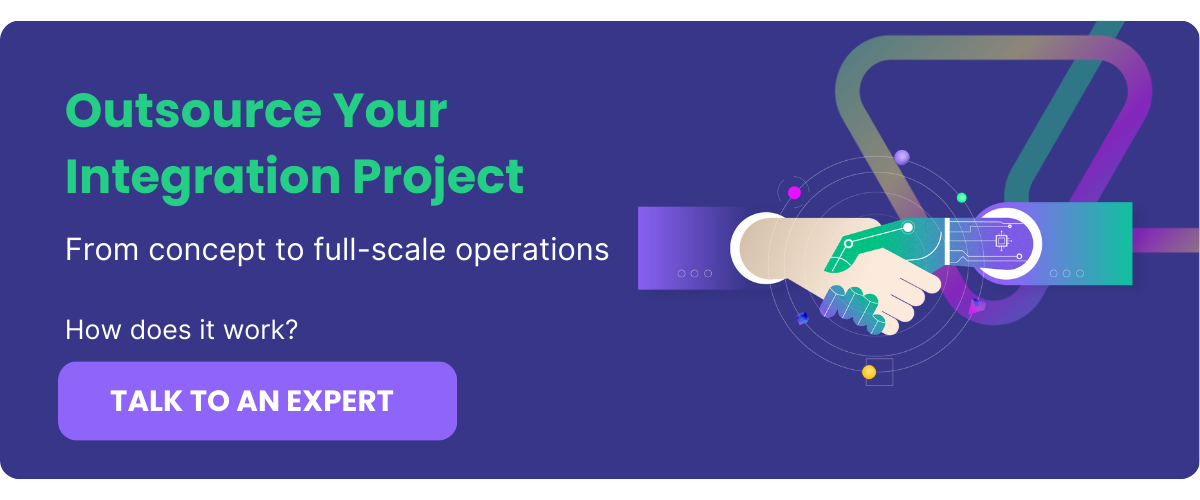Enterprises are transforming the way they work, favoring modern cloud-based solutions over traditional on-premise counterparts. This shift fuels digital transformation, prompting them to look into diverse ways to integrate everyday systems. The outcome? The birth of Integration Software as a Service (iSaaS).
iSaaS welcomes this change by provisioning cloud-based solutions to integration problems. With pre-built connectors and a pay-as-you-go model, iSaaS solutions can redefine how you handle your integrations.
In this blog post, we delve into the intricacies of iSaaS, exploring its practical applications and future trajectories. We’ll also navigate through some prominent iSaaS vendors, accompanied by best practices, to get the most out of your iSaaS effort.

What is iSaaS?
Integration Software as a Service (iSaaS) is a cloud-based solution that makes it easy for software applications to share and exchange data without any hiccups.
Imagine your business uses software for various tasks – one for sales, one for customer management, and one for development. Without integration, these systems operate in silos, leading to inefficiencies and data discrepancies.
iSaaS steps in to bridge this gap by connecting all these pieces together, allowing them to communicate effectively.
For example, when a new critical customer ticket comes in an ITSM tool like ServiceNow, iSaaS ensures that the development team is updated on the incident in their system, Jira. Such automation between workflows ensures every team member is aware of what’s cooking in kitchens that matter to them.
iSaaS providers offer cloud-based solutions to facilitate communication between systems that lack inherent communication capabilities.
In contrast to the traditional on-premise integration solutions, iSaaS exhibits the following characteristics.
Key Features of iSaaS
Cloud-Based Architecture
Unlike on-premise solutions, iSaaS leverages the power of the cloud. This means that the infrastructure supporting the integration process is hosted and managed by third-party cloud providers.
Scalability
iSaaS provides businesses the capability to scale their integration processes effectively. Imagine your business growing, and with iSaaS, imagine your integration capabilities growing proportionally.

In such a case, adding new applications or ITSM tools to integrate becomes a walk in the park.
Flexibility
The flexibility that iSaaS offers allows organizations to adapt to changing business needs swiftly. Whether integrating new tools, adapting new workflows, or evolving integration needs, iSaaS embraces all these changes without requiring significant reconfiguration.
Cost-Effectiveness
Embracing a pay-as-you-go model, iSaaS significantly reduces upfront costs and overall ownership expenses.

This makes it appealing, especially for small and medium-sized enterprises (SMEs) seeking cost-effective integration solutions.
Plug-and-Play Connectors
One of the hallmarks of iSaaS is the provision of plug-and-play connectors. The connectors provide automatic bridges, aka integrations between popular software applications. This out-of-the-box functionality enables a quick and easy setup without the need for extensive coding.
For example, an iSaaS solution may provide a ready-to-use connector for Salesforce, connecting it with other tools like Jira, ServiceNow, etc.
The integration landscape is constantly evolving, and so are integration solution providers. With time these providers introduce newer ways of handling integrations, often leaving consumers confused with too many choices.
You might have heard of one such term – Integration Platform as a Service (iPaaS). Which brings us to our next question. How does iPaaS and iSaaS differ? Let’s answer this now.
What is the Difference between iPaaS and iSaaS?
iPaaS functions as a cloud-based integration platform that facilitates an adaptive integration approach. In simpler terms, it serves as a platform for creating and deploying integrations within cloud applications and between the cloud and on-premises applications.
Conversely, iSaaS operates as a cloud-based application that empowers users to create new integration flows by configuring them rather than starting from scratch.
In essence, both iPaaS and iSaaS are cloud-based and offer certain similar capabilities.
- SaaS application connectors. For instance, Salesforce, ServiceNow, etc.
- On-premise application connectors. For instance, Azure DevOps Server.
- Granular data transformation and mapping capabilities
- Pre-built integration operations and templates
- Multiple licensing models
- Other integration capabilities
Considering their overlapping nature, implementing one out of the two completely depends on organizational requirements and resource availability.
For developers, who can dedicate time to writing and building their integration code, iPaaS is as simple as changing a URL. For no-code lovers, iSaaS is the way forward. Still, many iSaaS vendors offer a low-code approach in addition to pre-built templates which makes them a coveted choice.

Now that we’ve grasped the essence of Integration Software as a Service (iSaaS), let’s delve into some real-world applications.
How does this digital glue manifest its utility in various business scenarios?
Applications of iSaaS
Consolidating Services in an MSP Setup
Managed Service Providers (MSPs) have conflicting systems with their customers. Often, these MSPs need to exchange information with their customers without manual mediation.
Moreover, they all have unique workflows, adding to their communication woes. With an iSaaS in place, these systems can communicate effectively, through an MSP integration, feeding each other’s workflows with only the required information. Everything is automatic and in real-time. Efficiency at its best!
Connecting Backend and Frontend Teams
Consider a software development project resting in Jira and customer tickets flowing into Zendesk.
Critical customer tickets might need the dev team’s attention. Manually passing them won’t make the cut. iSaaS will ensure the required ticket information is passed to Jira. Additionally, statuses between the two systems will be up-to-date, so the support agent always has the answer to customer questions.
Sometimes, multiple tickets need to be mapped to a single dev issue since it might be the same problem. iSaaS can handle all this gracefully.
Optimizing CRM and Marketing Operations
Sales and marketing might use tools like Salesforce and HubSpot. Using iSaaS to integrate these tools means having a 360-degree view of customer interactions and experiences. An integration ensures customer data is visible to all the relevant applications.
For instance, when a sales team member updates some customer information, it is uniformly reflected in any connected systems.
While iSaaS brings in a plethora of advantages, it’s essential to navigate through the potential challenges that you may encounter in your integration journey.
Challenges and Considerations in Integration Software as a Service
Data Security
As data travels between multiple systems, it must remain safe and secure. iSaaS platforms address these concerns using various security measures like encryption, authentication, etc.

However, it’s crucial to be watchful and alert while choosing an iSaaS provider, ensuring they check all your security requirements. Get a thorough overview of their security protocols and techniques.
For instance, some iSaaS tools provide additional security mechanisms like single-tenancy.
Customization Requirements
Every business operates uniquely with distinct processes and requirements. iSaaS solutions offer pre-defined connectors for popular applications, but you might require customization for special needs. While iSaaS aims for simplicity, businesses should evaluate the level of customization the platform allows and ensure it aligns with their individual requirements.
Integration with Legacy Systems
Many businesses still rely on legacy systems not inherently meant to integrate with modern cloud-based solutions. iSaaS bridges this gap. However, challenges may arise in adapting older technologies to the integration process.
You need to carefully plan and strategize the process of integrating your legacy systems to ensure a smooth transition.
Best Practices for iSaaS Implementation
To overcome these challenges, you can choose to follow certain best practices.
- Monitoring and Governance: Though iSaaS offers top-notch monitoring capabilities, your business must establish proper governance practices to complement it. Without careful oversight, integration processes may lead to undesired consequences like system overloads.
- Cost Management: While iSaaS is generally cost-effective, businesses need to carefully manage costs, especially as the integration scales. The pay-as-you-go model can become expensive if not monitored closely. Consider monitoring your usage, optimizing pricing plans, and regularly assessing the ROI.
- User Training and Adoption: Introducing iSaaS into your workflows requires user training and adoption. The simplicity of iSaaS is a strength, but users must still understand how to leverage its features effectively.
While you embark on your journey to leverage Integration Software as a Service, it’s crucial to explore the landscape of major iSaaS providers in the market.
Leading iSaaS Providers
Let’s take a closer look at the key players.
1. MuleSoft
MuleSoft, a Salesforce company, is renowned for its Anypoint Platform, offering a comprehensive solution for application programming interface (API) management and integration. MuleSoft’s platform provides a unified integration approach, enabling businesses to connect applications, data, and devices seamlessly.
2. Dell Boomi
Dell Boomi stands out for its cloud-based integration platform that empowers businesses to connect applications and data across various environments. Known for its simplicity and flexibility, Dell Boomi offers a visual interface for designing integration processes, making it accessible to both technical and non-technical users.
3. Exalate
Exalate is a standout iSaaS provider specializing in ongoing and robust bidirectional synchronization. Recognized for its ability to connect various tools such as Jira, ServiceNow, GitHub, etc., Exalate facilitates seamless collaboration between different platforms.

The future of Integration Software as a Service (iSaaS) holds exciting possibilities as its landscape continues to evolve.
4. Informatica
Informatica is a leader in cloud data integration and provides a versatile iSaaS solution. The Informatica Intelligent Cloud Services platform allows businesses to integrate data across cloud and on-premises environments, supporting a wide range of use cases from data migration to real-time data synchronization.
Future Trends in iSaaS
Key trends shaping the future of iSaaS are as follows.
Artificial Intelligence (AI) and Machine Learning (ML) in Integration
iSaaS platforms are incorporating AI and ML to enhance automation, data mapping, and predictive analytics. This trend further enhances the integration process, making it more adaptive and responsive to evolving business needs.
Evolution of No-code/ Low-code iSaaS Platforms
Even while the essence of iSaaS is to provide pre-built integration patterns, what makes them lucrative is their ability to offer a low-code approach to integrations. These low-code scripts/snippets further enhance your experience with granular control over your integration use case and configure it easily to even your most complex needs.
Advancements in Integration Delivery and Approach
For a truly remote and distributed world, integrations can no longer remain static. They need to be distributed, agile, and flexible enough to connect companies crossing geographical boundaries. iSaaS platforms like Exalate offer single-tenancy, decentralized integration, and low-code modes to align with modern integration requirements.
By staying attuned to these future trends, you can strategically position yourself to harness the full potential of iSaaS.
Conclusion
Integration Software as a Service (iSaaS) reshapes how businesses connect, automate, and thrive in the digital realm. It offers a streamlined path to unified data exchange. As businesses prioritize scalability and cost-effectiveness, the right iSaaS provider becomes a strategic ally, bringing low-code customization alongwith plug-and-play simplicity and AI-driven insights.
Frequently Asked Questions
What sets Integration Software as a Service (iSaaS) apart from traditional integration solutions?
iSaaS distinguishes itself from traditional integration solutions by operating in the cloud, offering scalability, flexibility, and accessibility. Unlike traditional on-premises solutions, iSaaS facilitates seamless data exchange between diverse applications through plug-and-play connectors. This cloud-based approach enhances efficiency and reduces upfront costs, making it an ideal choice for businesses seeking modern, scalable integration solutions.
How do iSaaS providers ensure the security of data during integration processes?
iSaaS providers prioritize data security through robust encryption, authentication, and authorization protocols. Reputable iSaaS platforms guarantee secure integration and adhere to industry compliance standards, instilling confidence in businesses while meeting regulatory requirements. Some iSaaS providers like Exalate also have additional security features like single-tenancy, decentralized integration, etc.
What role does Integration Software as a Service play in the future of business operations?
iSaaS is poised for a transformative role, integrating Artificial Intelligence and Machine Learning for automated processes. As businesses embrace the Internet of Things, iSaaS becomes a key enabler, connecting devices seamlessly. Evolution in integration standards ensures a future-ready, interoperable digital dialogue for agile business ecosystems.
Recommended Reading:
- Integration as a Service (IaaS): Everything Explained
- ITSM Integration: Simplify Your IT Services Like Never Before
- How to Implement a Two-Way Integration Between Platforms
- Enterprise Integration Platforms: Making Your Business Systems Click
- Exploring the Working Principles of Service Desk Integration
- MSP Integration: Why It Matters for Your Business





